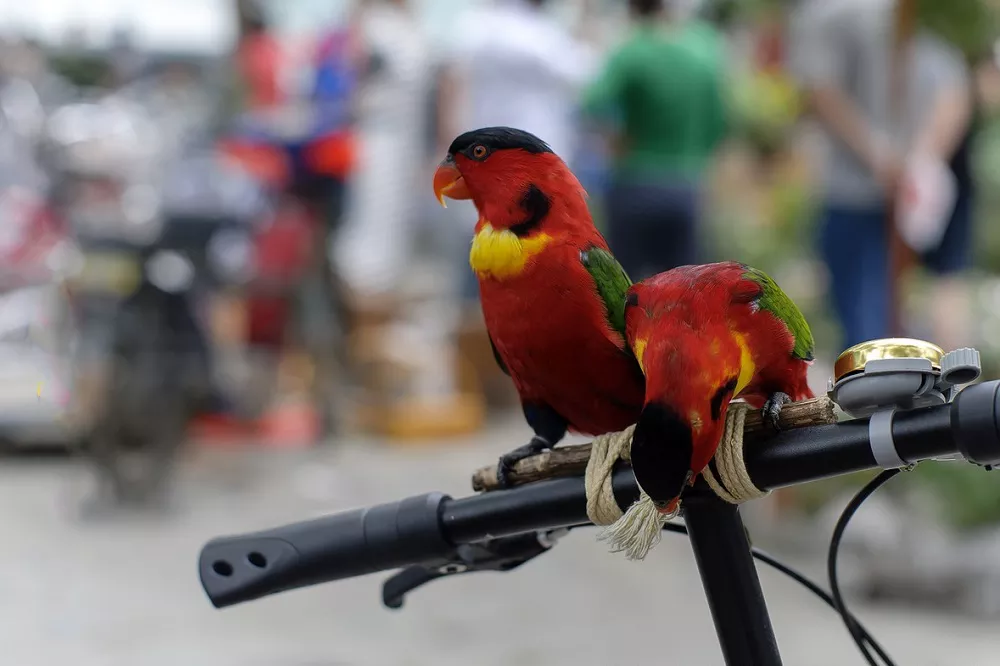The Duchess Lorikeet (Charmosyna margarethae), also known as the Duchess’s Lorikeet, is a captivating and colorful parrot species native to the rainforests of New Guinea. Named in honor of Duchess Margaret of Argyll, this small lorikeet possesses a distinctive appearance that sets it apart from other avian species. This article provides a detailed exploration of the physical characteristics and visual traits that define the stunning beauty of the Duchess Lorikeet.
Physical Characteristics:
Size: The Duchess Lorikeet is a small-sized parrot, measuring approximately 8 to 9 inches (20-23 cm) in length. It belongs to the family Psittaculidae and is renowned for its vibrant and striking coloration.
Plumage: The plumage of the Duchess Lorikeet is a mesmerizing blend of vibrant colors. The upperparts, including the head, back, and wings, exhibit a lush forest green hue. The feathers on the wings often have a glossy appearance, adding to their allure. The underparts and the throat display a rich red color, creating a striking contrast against the green plumage.
Beak and Eyes: The Duchess Lorikeet features a slender and slightly curved beak, characteristic of the lorikeet family. The beak is primarily black in color. The eyes are large and surrounded by a narrow, white eye-ring, which enhances their visibility and gives the bird a distinct expression.
Tail: The tail of the Duchess Lorikeet is relatively short, with rounded tips to the individual feathers. The tail feathers generally have a dark green coloration, complementing the overall appearance of the bird.
Sexual Dimorphism: Male and female Duchess Lorikeets share a similar appearance, making it difficult to visually distinguish between the sexes based on physical characteristics alone. DNA testing or behavioral cues are often necessary for accurate gender identification.
Juvenile Plumage:
Juvenile Duchess Lorikeets have a distinct appearance compared to adults. Their plumage is predominantly green, with less defined red and blue coloration. As they mature, their colors intensify, becoming more vibrant and defined.
Vocalizations:
While the visual beauty of the Duchess Lorikeet is undoubtedly captivating, its vocalizations are equally enchanting. These parrots emit a variety of calls, including high-pitched whistles, trills, and chattering sounds. They are known for their playful and melodious nature, often engaging in lively vocal exchanges within flocks.
Behavior and Habitat:
Duchess Lorikeets are typically found in the tropical rainforests and mountainous regions of Papua New Guinea. They are highly social birds, often forming small flocks or pairs. These lorikeets are agile flyers, capable of swift and acrobatic movements as they navigate through the dense foliage of their natural habitat.
Feeding Habits:
As nectarivores, Duchess Lorikeets primarily feed on the nectar of various flowering plants. Their brush-tipped tongues are specifically adapted for lapping up nectar from deep within flowers. In addition to nectar, they supplement their diet with pollen, fruits, seeds, and occasional insects.
Conservation Status:
The Duchess Lorikeet is classified as a vulnerable species by the International Union for Conservation of Nature (IUCN). Habitat loss due to deforestation, as well as trapping for the illegal pet trade, pose significant threats to their population. Efforts are being made to protect their habitats and raise awareness about the importance of conservation.
Captive Care:
Due to their stunning appearance, some avian enthusiasts may be interested in keeping Duchess Lorikeets as pets. However, it is crucial to understand the responsibilities and requirements associated with their care. Proper housing, a balanced diet consisting of nectar substitutes, fresh fruits, and vegetables, as well as mental stimulation through toys and social interaction, are essential for their well-being.
Conclusion:
The Duchess Lorikeet is an exceptional parrot species cherished for its stunning appearance and captivating behavior. With its vibrant green, red, and blue plumage, along with its melodious vocalizations, this bird has earned a special place among avian enthusiasts. While their natural habitat faces challenges, efforts to protect them and conserve their populations are crucial for the future of these magnificent birds.


 Facebook
Facebook  Instagram
Instagram  Youtube
Youtube 